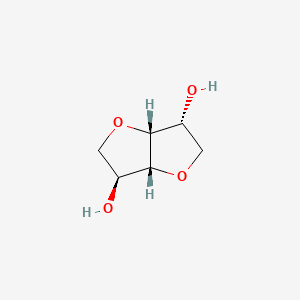



1. Dianhydrosorbitol
1. 652-67-5
2. Isobide
3. Devicoran
4. Hydronol
5. Ismotic
6. 1,4:3,6-dianhydro-d-glucitol
7. Sorbid
8. (3r,3ar,6s,6ar)-hexahydrofuro[3,2-b]furan-3,6-diol
9. (+)-d-isosorbide
10. Vascardin Dinitrate
11. Dianhydro-d-glucitol
12. D-glucitol, 1,4:3,6-dianhydro-
13. 1,4-dianhydrosorbitol
14. At-101
15. 1,4:3,6-dianhydro-d-sorbitol
16. 1,4:3,6-dianhydrosorbitol
17. D-isosorbide
18. (3s,3ar,6r,6ar)-2,3,3a,5,6,6a-hexahydrofuro[3,2-b]furan-3,6-diol
19. Nsc-40725
20. Wxr179l51s
21. Sorbitol, 1,4:3,6-dianhydro-
22. Nsc40725
23. D-1,4:3,6-dianhydroglucitol
24. Ncgc00160508-01
25. Isosorbide 100 Microg/ml In Acetonitrile
26. Glucitol, 1,4:3,6-dianhydro-, D-
27. Dsstox_cid_26196
28. Dsstox_rid_81427
29. Dsstox_gsid_46196
30. Hydronol (van)
31. Isosorbida
32. Isosorbidum
33. Isosorbidum [inn-latin]
34. Polysorb P
35. Polysorb Ps
36. Isosorbida [inn-spanish]
37. Cas-652-67-5
38. Hsdb 3105
39. Einecs 211-492-3
40. Nsc 40725
41. Brn 0080510
42. Unii-wxr179l51s
43. Ismotic (tn)
44. Isobide (tn)
45. Mfcd00064827
46. Isosorbide [usan:usp:inn:ban:jan]
47. 1,6-dianhydrosorbitol
48. Isosorbide [mi]
49. Isosorbide [inn]
50. Isosorbide [jan]
51. Isosorbide [hsdb]
52. Isosorbide [inci]
53. Isosorbide [usan]
54. Isosorbide [vandf]
55. 1,6-dianhydro-d-glucitol
56. 1,6-dianhydro-d-sorbitol
57. Ec 211-492-3
58. Isosorbide [mart.]
59. Isosorbide [usp-rs]
60. Isosorbide [who-dd]
61. Dianhydro-d-glucitol, 98%
62. Schembl15495
63. 1,4:3,6-dianhydroglucitol
64. 5-19-03-00201 (beilstein Handbook Reference)
65. Bidd:gt0695
66. 1,4; 3,6-dianhydrosorbitol
67. Chebi:6060
68. Isosorbide (jp17/usp/inn)
69. D-glucitol,4:3,6-dianhydro-
70. Chembl1200660
71. Dtxsid5046196
72. Isosorbide [orange Book]
73. 1.4:3.6-dianhydro-d-glucitol
74. 1.4;3.6-dianhydro-d-glucitol
75. Isosorbide [usp Impurity]
76. Glucitol,4:3,6-dianhydro-, D-
77. Hy-b1469
78. Tox21_111861
79. Bbl029591
80. S4204
81. Stk801813
82. Zinc18284778
83. Akos005622709
84. Tox21_111861_1
85. Ccg-266173
86. Cs-5157
87. Db09401
88. Smp1_000177
89. Ncgc00160508-02
90. Ncgc00160508-03
91. As-14140
92. I0407
93. D00347
94. Ab01566931_01
95. Q1243800
96. Z2785909604
97. A912284d-27e1-4fb0-91b8-86c8ab905297
98. Wurcs=2.0/1,1,0/[h2122h_1-4_3-6]/1/
99. D-sorbitol, {1,4:3,6-dianhydro(furo[3,2-b]furan-3,6-diol,} Hexahydro-)
100. D-sorbitol,4:3,6-dianhydro(furo[3,2-b]furan-3,6-diol, Hexahydro-)
| Molecular Weight | 146.14 g/mol |
|---|---|
| Molecular Formula | C6H10O4 |
| XLogP3 | -1.4 |
| Hydrogen Bond Donor Count | 2 |
| Hydrogen Bond Acceptor Count | 4 |
| Rotatable Bond Count | 0 |
| Exact Mass | 146.05790880 g/mol |
| Monoisotopic Mass | 146.05790880 g/mol |
| Topological Polar Surface Area | 58.9 Ų |
| Heavy Atom Count | 10 |
| Formal Charge | 0 |
| Complexity | 122 |
| Isotope Atom Count | 0 |
| Defined Atom Stereocenter Count | 4 |
| Undefined Atom Stereocenter Count | 0 |
| Defined Bond Stereocenter Count | 0 |
| Undefined Bond Stereocenter Count | 0 |
| Covalently Bonded Unit Count | 1 |
Diuretics, Osmotic
National Library of Medicine's Medical Subject Headings online file (MeSH, 1999)
...IS ORAL OSMOTIC AGENT USED FOR EMERGENCY TREATMENT OF ACUTE ANGLE-CLOSURE GLAUCOMA & OTHER CONDITIONS IN WHICH RAPID REDUCTION IN INTRAOCULAR PRESSURE & VITREOUS VOLUME IS INDICATED.
American Medical Association, AMA Department of Drugs. AMA Drug Evaluations. 4th ed. Chicago: American Medical Association, 1980., p. 366
ISOSORBIDE PRODUCES MORE SIGNIFICANT DIURESIS THAN GLYCERIN & CATHETERIZATION MAY BE NECESSARY.
American Medical Association, AMA Department of Drugs. AMA Drug Evaluations. 4th ed. Chicago: American Medical Association, 1980., p. 366
USE OF ISOSORBIDE STUDIED IN 23 CHILDREN WITH MYELODYSPLASIA & HYDROCEPHALUS. HEAD GROWTH RATE SIGNIFICANTLY DECR IN 18 PATIENTS. CEREBROSPINAL FLUID FLOW DECR BY 50% IN 12 ISOSORBIDE TRIALS. DRUG IS OF BENEFIT FOR TEMPORARY USE PRIOR TO INSERTION OF MECHANICAL SHUNT SYSTEM.
SHURTLEFF DB ET AL; J PEDIAT 83(OCT) 651 (1973)
For more Therapeutic Uses (Complete) data for ISOSORBIDE (8 total), please visit the HSDB record page.
Isosorbide was previously indicated for temporary reduction of intraocular pressure and used to interrupt an acute glaucoma attack, however, this is not a currently approved indication. Refer to [isosorbide mononitrate] and [isosorbide dinitrate] drug entries for more isosorbide indications.
FDA Label
Isosorbide reduces intraocular pressure through its effects on ocular blood vessels. While in the blood, isosorbide promotes redistribution of water toward the circulation, promoting the excretion of urine.
Diuretics, Osmotic
Compounds that increase urine volume by increasing the amount of osmotically active solute in the urine. Osmotic diuretics also increase the osmolarity of plasma. (See all compounds classified as Diuretics, Osmotic.)
Absorption
Isosorbide is rapidly absorbed after oral administration. Refer to [isosorbide mononitrate] for detailed absorption information.
IN DOGS, 5.5 MILLIMOLES/KG IV CAUSED LESS SOLUTE EXCRETION THAN AN EQUIMOLAR DOSE OF MANNITOL. THE DISTRIBUTION SPACE OF LABELED ISOSORBIDE WAS 54% OF BODY WT IN INTACT & NEPHRECTOMIZED DOGS. PROXIMAL TUBULAR REABSORPTION OF ISOSORBIDE WAS PROBABLY PASSIVE.
SHINABERGER JH ET AL; J PHARMACOL EXP THER 158(3) 460 (1967)
TEN NORMAL MALES RECEIVED 0.25-1.5 G/KG ISOSORBIDE. DOSE RESPONSE EFFECTS ON WATER & OSMOLAR EXCRETION STATISTICALLY SIGNIFICANT. IN 9 VOLUNTEERS, ORALLY ADMIN ISOSORBIDE APPEARED RAPIDLY IN PLASMA & EXCRETED IN URINE WITH MEAN DISAPPEARANCE HALF-LIFE OF 8 HR.
NODINE JH ET AL; CLIN PHARMACOL THER 14(MAR-APR) 196 (1973)
ISOSORBIDE WAS RAPIDLY ABSORBED BY HUMANS FOLLOWING ORAL ADMIN & WAS EXCRETED UNCHANGED VIA KIDNEY WITH A MEAN DISAPPEARANCE T/2 OF APPROX 7 HR. IT INCREASED URINE VOLUME, CREATININE CLEARANCE, & SODIUM & CHLORIDE EXCRETION.
MODI KN ET AL; NEUROL INDIA 20(SUPPL 1) 122 (1972)
RABBITS GIVEN ORAL DOSES OF 2 G/KG FOR 1-7 DAYS HAD EST EXCRETION T/2 OF LESS THAN 6 HR IN ALL EYE TISSUE. PEAK LEVEL & EXCRETION T/2 WAS SIMILAR IN DAMAGED & UNDAMAGED EYE TISSUE, EXCEPT IN LENS OF DAMAGED EYES IN WHICH EXCRETION T/2 WAS SHORTER THAN OF NORMAL EYES.
HART LG ET AL; PROC SOC EXP BIOL MED 140(2) 715 (1972)
Isosorbide causes vascular relaxation, reducing systolic ophthalmic artery pressure (SOAP), systolic ocular perfusion pressure (SOPP).